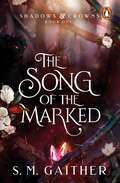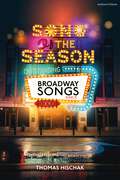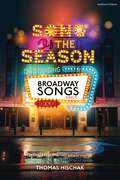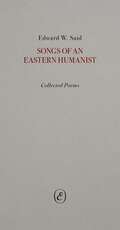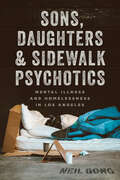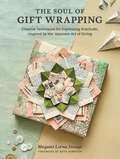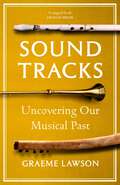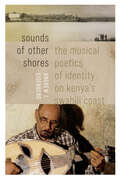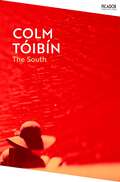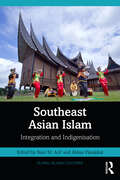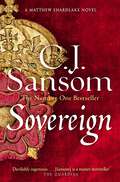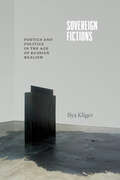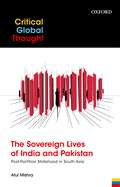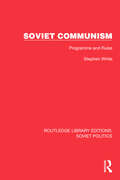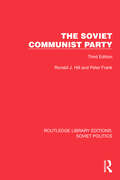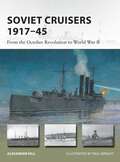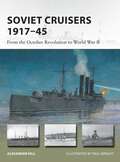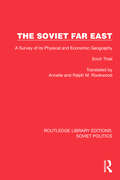- Table View
- List View
The Song of the Marked: The thrilling, enemies to lovers, romantic fantasy and TikTok sensation (Shadows & Crowns #1)
by S. M. GaitherThe old gods are growing restless...Mercenary Casia Greythorne cares about two things: completing her latest job and earning enough coin for the expensive medicine that's keeping her mentor alive.So when the king commands her to investigate a strange plague devastating the empire, she can't resist the massive reward he offers - even if it does mean working with the arrogant and infuriating Captain Elander.But as the death toll rises and strange monsters wreak havoc across the realms, Cas and Elander find themselves up against meddling gods and very old magic.Because an ancient evil is stirring in the shadows.And their empire will not survive its full unleashing.The first book in the thrilling Shadows & Crowns series - perfect for fans of Sarah J. Maas' Throne of Glass and Leigh Bardugo's Six of Crows!_______'Absolutely INCREDIBLE' 5* reader review'NEW FANTASY OBSESSION.' 5* reader review
Song of the Season: Outstanding Broadway Songs since 1891
by Thomas HischakWhat links the popular songs "You'll Never Walk Alone", "Send in the Clowns", "Memory" and "I Am What I Am"? They all originated in Broadway musicals. Song of the Season is for those who believe that the score is at the heart of a musical and is the essential building block on which the rest of a show is built. Through a systematic historical survey from 1891 to 2023 it argues that the best musicals survive because of their songs, from early 20th century classics such as Show Boat and Oklahoma! through to the contemporary sound of Dear Evan Hansen and Hamilton. looking at outstanding songs from each Broadway season, the development and history of the musical is illustrated with a fresh perspective. As song styles and popular music tastes changed throughout the decades this structure charts the progress of American showtunes alongside popular music forms as songs evolved from the waltz and ragtime to jazz, rock, rap and hip-hop. Factual analysis and historical context combine to offer a rich picture of the American songbook from Irving Berlin to Elton John. Song of the Season paints a fresh picture for musical theatre students and fans alike, illustrating significant changes in the form through the music. Analyzed in an accessible and engaging way that doesn't rely on music theory knowledge, and including a link to playlist where all the 'songs of the seasons' can be listened to, it is a must-have for those looking to expand their knowledge of the form and trace the social history of the American showtune.
Song of the Season: Outstanding Broadway Songs since 1891
by Thomas HischakWhat links the popular songs "You'll Never Walk Alone", "Send in the Clowns", "Memory" and "I Am What I Am"? They all originated in Broadway musicals. Song of the Season is for those who believe that the score is at the heart of a musical and is the essential building block on which the rest of a show is built. Through a systematic historical survey from 1891 to 2023 it argues that the best musicals survive because of their songs, from early 20th century classics such as Show Boat and Oklahoma! through to the contemporary sound of Dear Evan Hansen and Hamilton. looking at outstanding songs from each Broadway season, the development and history of the musical is illustrated with a fresh perspective. As song styles and popular music tastes changed throughout the decades this structure charts the progress of American showtunes alongside popular music forms as songs evolved from the waltz and ragtime to jazz, rock, rap and hip-hop. Factual analysis and historical context combine to offer a rich picture of the American songbook from Irving Berlin to Elton John. Song of the Season paints a fresh picture for musical theatre students and fans alike, illustrating significant changes in the form through the music. Analyzed in an accessible and engaging way that doesn't rely on music theory knowledge, and including a link to playlist where all the 'songs of the seasons' can be listened to, it is a must-have for those looking to expand their knowledge of the form and trace the social history of the American showtune.
Songs of an Eastern Humanist
by Edward Said"Considering the emphasis in Said's critical work on space and place and the political importance of geography, it is less surprising to see the luxuriant evocation of a specific topography of dusty roads, grottos, plump figtrees, desert flowers, muddy clods, and the 'beckoning hands of lambent hills'. Most revealing of all, perhaps, is the poems' tendency to see the world through musical form. Musical imagery is everywhere, testifying to how much of Said's mind in an introspective mood was immersed in the sounds, forms, and fables of Western classical music."—Timothy Brennan, from the book's Introduction Edward Said was renowned for the breadth, erudition, and humanity of his scholarly and political writing. His ground-breaking studies of literature and culture threw a dazzling new light on the ways in which non-Western peoples have been misrepresented over the course of the centuries, and he was among the world's most prominent voices in denouncing the modern-day injustices of Western foreign policy. This volume collects all of his never-before-published poems, offering insight into the personality of the author of Orientalism, The World, the Text and the Critic, and Culture & Imperialism "to a degree hidden in those works themselves". The nineteen works collected in Songs of an Eastern Humanist canvass a variety of poetic forms, but they are all shot through with Said's capacious intellect and passionate sensibility. They are also remarkable achievements of poetic craft. Said's poetry alternates with unerring judgment between wit and pathos, between sublimely elevated and disarmingly quotidian registers. His individual lines of verse are exquisitely constructed and richly elusive, while his poems as a whole are at once sweeping in their vision and keenly evocative of sensory experience. Their publication amounts to a major literary event, marking twenty years since the great public intellectual's passing.
Sons, Daughters, and Sidewalk Psychotics: Mental Illness and Homelessness in Los Angeles
by Neil GongSociologist Neil Gong explains why mental health treatment in Los Angeles rarely succeeds, for the rich, the poor, and everyone in between. In 2022, Los Angeles became the US county with the largest population of unhoused people, drawing a stark contrast with the wealth on display in its opulent neighborhoods. In Sons, Daughters, and Sidewalk Psychotics, sociologist Neil Gong traces the divide between the haves and have-nots in the psychiatric treatment systems that shape the life trajectories of people living with serious mental illness. In the decades since the United States closed its mental hospitals in favor of non-institutional treatment, two drastically different forms of community psychiatric services have developed: public safety-net clinics focused on keeping patients housed and out of jail, and elite private care trying to push clients toward respectable futures. In Downtown Los Angeles, many people in psychiatric crisis only receive help after experiencing homelessness or arrests. Public providers engage in guerrilla social work to secure them housing and safety, but these programs are rarely able to deliver true rehabilitation for psychological distress and addiction. Patients are free to refuse treatment or use illegal drugs—so long as they do so away from public view. Across town in West LA or Malibu, wealthy people diagnosed with serious mental illness attend luxurious treatment centers. Programs may offer yoga and organic meals alongside personalized therapeutic treatments, but patients can feel trapped, as their families pay exorbitantly to surveil and “fix” them. Meanwhile, middle-class families—stymied by private insurers, unable to afford elite providers, and yet not poor enough to qualify for social services—struggle to find care at all. Gong’s findings raise uncomfortable questions about urban policy, family dynamics, and what it means to respect individual freedom. His comparative approach reminds us that every “sidewalk psychotic” is also a beloved relative and that the kinds of policies we support likely depend on whether we see those with mental illness as a public social problem or as somebody’s kin. At a time when many voters merely want streets cleared of “problem people,” Gong’s book helps us imagine a fundamentally different psychiatric system—one that will meet the needs of patients, families, and society at large.
Sons, Daughters, and Sidewalk Psychotics: Mental Illness and Homelessness in Los Angeles
by Neil GongSociologist Neil Gong explains why mental health treatment in Los Angeles rarely succeeds, for the rich, the poor, and everyone in between. In 2022, Los Angeles became the US county with the largest population of unhoused people, drawing a stark contrast with the wealth on display in its opulent neighborhoods. In Sons, Daughters, and Sidewalk Psychotics, sociologist Neil Gong traces the divide between the haves and have-nots in the psychiatric treatment systems that shape the life trajectories of people living with serious mental illness. In the decades since the United States closed its mental hospitals in favor of non-institutional treatment, two drastically different forms of community psychiatric services have developed: public safety-net clinics focused on keeping patients housed and out of jail, and elite private care trying to push clients toward respectable futures. In Downtown Los Angeles, many people in psychiatric crisis only receive help after experiencing homelessness or arrests. Public providers engage in guerrilla social work to secure them housing and safety, but these programs are rarely able to deliver true rehabilitation for psychological distress and addiction. Patients are free to refuse treatment or use illegal drugs—so long as they do so away from public view. Across town in West LA or Malibu, wealthy people diagnosed with serious mental illness attend luxurious treatment centers. Programs may offer yoga and organic meals alongside personalized therapeutic treatments, but patients can feel trapped, as their families pay exorbitantly to surveil and “fix” them. Meanwhile, middle-class families—stymied by private insurers, unable to afford elite providers, and yet not poor enough to qualify for social services—struggle to find care at all. Gong’s findings raise uncomfortable questions about urban policy, family dynamics, and what it means to respect individual freedom. His comparative approach reminds us that every “sidewalk psychotic” is also a beloved relative and that the kinds of policies we support likely depend on whether we see those with mental illness as a public social problem or as somebody’s kin. At a time when many voters merely want streets cleared of “problem people,” Gong’s book helps us imagine a fundamentally different psychiatric system—one that will meet the needs of patients, families, and society at large.
The Soul of Gift Wrapping: Creative Techniques for Expressing Gratitude, Inspired by the Japanese Art of Giving
by Megumi Lorna InouyeWith a combination of inventive wrapping designs, inspiring personal essays, and step-by-step techniques, Megumi Inouye invites readers to transform the act of wrapping into a gratitude practice. Drawing on the gift-giving traditions of her Japanese heritage, Inouye explores how the act of giving a thoughtfully wrapped gift can be a creative, caring act for both the giver and the receiver. Using recycled and repurposed materials, Inouye&’s approach inspires readers to think intentionally about the presentation of every gift, whether it's a tip for an unseen hotel housekeeper, a simple gift of fresh fruit for a neighbor, or a special birthday gift for a beloved family member. Detailed step-by-step photos teach Inouye's artful approach to every aspect of wrapping—including tape-free folding, paper and fabric bows, clever message tags, and one-of-a-kind approaches for odd-shaped items—and guide readers in creating their own unique gift presentations.
Sound Tracks: Uncovering Our Musical Past
by Graeme LawsonA transporting voyage of archaeological discovery: Sound Tracks unearths instruments from around the world and across time, releasing the past's musical secrets for the first time. ‘A thrilling journey into the sonic richness of human experience’ PHILIP BALL, author of The Music Instinct‘A magical book’ FRANCIS PRYOR, author of Britain BCFrom the present day back to the dawn of time, from dark caves and murky swamps to open deserts and ocean depths, here is the history of humankind's relationship with music in fifty detective stories.We see a child’s delight in Peru in AD 700, playing with a water-filled pot that chirps like a bird; we shiver with a lonely soldier sending trumpet signals to the next watchtower on Hadrian's Wall; we sway to the stately rhythms of the 64 bells buried in a tomb in China in the 5th century BC. And on this grand tour, we learn that music is part of what makes us human – a way of commemorating our pasts, communicating with others and shaping our lives.Brimming with astonishing insights, Sound Tracks provides an enthralling alternative history of humanity in which the silences of the past are filled with a glorious treasure hoard of vanished sounds and voices.‘Piles revelation upon revelation to shed a completely new perspective on the tools we use for making music’ NORMAN LEBRECHT, author of Why Beethoven‘Lawson has brilliantly conjured up the sounds of 30,000 years of human history’ DAVID ABULAFIA, Professor Emeritus of Mediterranean History
Sounds of Other Shores: The Musical Poetics of Identity on Kenya's Swahili Coast (Music / Culture)
by Andrew J. EisenbergSounds of Other Shores takes an ethnographic ear to the history of transoceanic stylistic appropriation in the Swahili taarab music of the Kenyan coast. Swahili taarab, a form of sung poetry that emerged as East Africa's first mass-mediated popular music in the 1930s, is a famously cosmopolitan form, rich in audible influences from across the Indian Ocean. But the variants of the genre that emerged in the Kenyan coastal city of Mombasa during the twentieth century feature particularly dramatic, even flamboyant, appropriations of Indian and Arab sonic gestures and styles. Combining oral history, interpretive ethnography, and musical analysis, Sounds of Other Shores explores how Swahili-speaking Muslims in twentieth-century Mombasa derived pleasure and meaning from acts of transoceanic musical appropriation, arguing that these acts served as ways of reflecting on and mediating the complexities and contradictions associated with being "Swahili" in colonial and postcolonial Kenya. The result is a musical anthropology of Kenyan Swahili subjectivity that reframes longstanding questions about Swahili identity while contributing to broader discussions about identity and citizenship in Africa and the Indian Ocean world.
The South: Picador Classic (Picador Classic #2)
by Colm TóibínWith an introduction by Roy FosterA classic work of Irish literature, this award-winning novel is an exploration of love, art and identity.This was the night train to Barcelona, some hours before the dawn. This was 1950, late September. I had left my husband. I had left my home. Katherine Proctor has dared to leave her family in Ireland and reach out for a new life. Determined to become an artist, she flees to Spain, where she meets Miguel, a passionate man who has fought for his own freedoms. They retreat to the quiet intensity of the mountains and begin to build a life together. But as Miguel's past catches up with him, Katherine too is forced to re-examine her relationships: with her lover, her painting and the homeland she only thought she knew. . .The South is the book that introduced readers to the astonishing gifts of Colm Tóibín, winning the Irish Times First Fiction Award in 1991. Arrestingly visual and enduringly atmospheric, it is a classic novel of art, sacrifice, and courage.* Pre-order Long Island, the stunning sequel to Tóibín's prize-winning, bestselling novel Brooklyn *
Southeast Asia in the New International Era
by Robert DayleyThis newly revised and updated ninth edition of Southeast Asia in the New International Era provides readers with contemporary coverage of a vibrant region home to more than 675 million people.Sensitive to historical legacies and paying special attention to developments since the end of the Cold War, this book highlights the events, players, and institutions that shape the region politically and economically. The scope of analysis provides context-specific treatment of the region’s 11 countries: Thailand, Myanmar (Burma), Vietnam, Cambodia, Laos, Philippines, Indonesia, Timor-Leste, Malaysia, Singapore, and Brunei. Three thematic chapters consider broader regional issues: Southeast Asia Political Economy, ASEAN, and South China Sea. Fully updated, the book’s revised content includes new discussion of the effects of the Covid-19 pandemic, Myanmar’s 2021 military coup, the return of the Marcos clan in the Philippines, political dynasty in Cambodia, youth demonstrations calling for monarchy reform in Thailand, Malaysia’s 2022 elections, and the relocation of Indonesia’s capital from sinking Jakarta to Borneo. New to this edition is a dedicated chapter explaining the territorial disputes in the South China Sea.An excellent resource for students and professionals seeking to understand Southeast Asia, this book helps make sense of the region’s political complexity while building a solid foundation for further study.
Southeast Asia in the New International Era
by Robert DayleyThis newly revised and updated ninth edition of Southeast Asia in the New International Era provides readers with contemporary coverage of a vibrant region home to more than 675 million people.Sensitive to historical legacies and paying special attention to developments since the end of the Cold War, this book highlights the events, players, and institutions that shape the region politically and economically. The scope of analysis provides context-specific treatment of the region’s 11 countries: Thailand, Myanmar (Burma), Vietnam, Cambodia, Laos, Philippines, Indonesia, Timor-Leste, Malaysia, Singapore, and Brunei. Three thematic chapters consider broader regional issues: Southeast Asia Political Economy, ASEAN, and South China Sea. Fully updated, the book’s revised content includes new discussion of the effects of the Covid-19 pandemic, Myanmar’s 2021 military coup, the return of the Marcos clan in the Philippines, political dynasty in Cambodia, youth demonstrations calling for monarchy reform in Thailand, Malaysia’s 2022 elections, and the relocation of Indonesia’s capital from sinking Jakarta to Borneo. New to this edition is a dedicated chapter explaining the territorial disputes in the South China Sea.An excellent resource for students and professionals seeking to understand Southeast Asia, this book helps make sense of the region’s political complexity while building a solid foundation for further study.
Southeast Asian Islam: Integration and Indigenisation (Global Islamic Cultures)
by Nasr M. Arif Abbas PanakkalThis book explores Muslim communities in Southeast Asia and the integration of Islamic culture with the diverse ethnic cultures of the region, offering a look at the practice of cultural and religious coexistence in various realms.The volume traces the origins and processes of adoption, transmission, and adaptation of Islam by diverse ethnic communities such as the Malay, Acehnese, Javanese, Sundanese, the Bugis, Batak, Betawi, and Madurese communities, among others. It examines the integration of Islam within local politics, cultural networks, law, rituals, education, art, and architecture, which engendered unique regional Muslim identities.Additionally, the book illuminates distinctive examples of cultural pluralism, cosmopolitanism, and syncretism that persisted in Islamic religious practices in the region owing to its maritime economy and reputation as a marketplace for goods, languages, cultures, and ideas.As part of the Global Islamic Cultures series that investigates integrated and indigenized Islam, this book will be of interest to students and researchers of theology and religion, Islamic studies, religious history, political Islam, cultural studies, and Southeast Asian studies. It also offers an engaging read for general audiences interested in world religions and cultures.
Southeast Asian Islam: Integration and Indigenisation (Global Islamic Cultures)
by Nasr M. Arif Abbas PanakkalThis book explores Muslim communities in Southeast Asia and the integration of Islamic culture with the diverse ethnic cultures of the region, offering a look at the practice of cultural and religious coexistence in various realms.The volume traces the origins and processes of adoption, transmission, and adaptation of Islam by diverse ethnic communities such as the Malay, Acehnese, Javanese, Sundanese, the Bugis, Batak, Betawi, and Madurese communities, among others. It examines the integration of Islam within local politics, cultural networks, law, rituals, education, art, and architecture, which engendered unique regional Muslim identities.Additionally, the book illuminates distinctive examples of cultural pluralism, cosmopolitanism, and syncretism that persisted in Islamic religious practices in the region owing to its maritime economy and reputation as a marketplace for goods, languages, cultures, and ideas.As part of the Global Islamic Cultures series that investigates integrated and indigenized Islam, this book will be of interest to students and researchers of theology and religion, Islamic studies, religious history, political Islam, cultural studies, and Southeast Asian studies. It also offers an engaging read for general audiences interested in world religions and cultures.
Sovereign: A Matthew Shardlake Mystery (The Shardlake series #3)
by C. J. Sansom'C. J. Sansom’s books are arguably the best Tudor novels going' – The Sunday TimesFollowing on from Dissolution and Dark Fire, Sovereign is the third gripping historical novel in C. J. Sansom's number one bestselling Shardlake series, perfect for fans of Hilary Mantel and Philippa Gregory.England, 1541. King Henry VIII has set out on a spectacular Progress to the North to attend an extravagant submission by his rebellious subjects in York.Already in the city are lawyer Matthew Shardlake and his assistant Jack Barak, whom have reluctantly undertaken a special mission for Archbishop Thomas Cranmer – to ensure the welfare of an important but dangerous conspirator who is to be returned to London for interrogation.But the murder of a York glazier involves Shardlake in deeper mysteries, connected not only to the prisoner in York castle but to the royal family itself. And when Shardlake and Barak stumble upon a cache of secret documents which could threaten the Tudor throne, a chain of events unfolds that will lead Shardlake to face the most terrifying fate of the age . . .This is the third novel in C. J. Sansom's internationally bestselling Shardlake series. It is followed by Revelation, the fourth book in the series.
Sovereign Fictions: Poetics and Politics in the Age of Russian Realism (Thinking Literature)
by Ilya KligerAn exploration of Russian realist fiction reveals a preoccupation with the absolutist state. The nineteenth-century novel is generally assumed to owe its basic social imaginaries to the ideologies, institutions, and practices of modern civil society. In Sovereign Fictions, Ilya Kliger asks what happens to the novel when its fundamental sociohistorical orientation is, as in the case of Russian realism, toward the state. Kliger explores Russian realism’s distinctive construals of sociality through a broad range of texts from the 1830s to the 1870s, including major works by Tolstoy, Dostoevsky, Gogol, Pushkin, Lermontov, Goncharov, and Turgenev, and several lesser-known but influential books of the period, including Alexander Druzhinin’s Polinka Saks (1847), Aleksei Pisemsky’s One Thousand Souls (1858), and Vasily Sleptsov’s Hard Times (1865). Challenging much current scholarly consensus about the social dynamics of nineteenth-century realist fiction, Sovereign Fictions offers an important intervention in socially inflected theories of the novel and in current thinking on representations of power and historical poetics.
Sovereign Fictions: Poetics and Politics in the Age of Russian Realism (Thinking Literature)
by Ilya KligerAn exploration of Russian realist fiction reveals a preoccupation with the absolutist state. The nineteenth-century novel is generally assumed to owe its basic social imaginaries to the ideologies, institutions, and practices of modern civil society. In Sovereign Fictions, Ilya Kliger asks what happens to the novel when its fundamental sociohistorical orientation is, as in the case of Russian realism, toward the state. Kliger explores Russian realism’s distinctive construals of sociality through a broad range of texts from the 1830s to the 1870s, including major works by Tolstoy, Dostoevsky, Gogol, Pushkin, Lermontov, Goncharov, and Turgenev, and several lesser-known but influential books of the period, including Alexander Druzhinin’s Polinka Saks (1847), Aleksei Pisemsky’s One Thousand Souls (1858), and Vasily Sleptsov’s Hard Times (1865). Challenging much current scholarly consensus about the social dynamics of nineteenth-century realist fiction, Sovereign Fictions offers an important intervention in socially inflected theories of the novel and in current thinking on representations of power and historical poetics.
The Sovereign Lives of India and Pakistan: Post-Partition Statehood in South Asia
by Atul MishraThe Sovereign Lives of India and Pakistan explores what it has meant for the two countries to act as sovereign states entangled at birth by an unsatisfactory partition. Sovereignty is conventionally understood as a means to achieve the goals that states set for themselves. This book argues that for India and Pakistan, sovereignty has become an end in itself, and that its pursuit has aided majoritarianism, insecurity, and mutual estrangement. It examines the trajectory of three problems that the partition of 1947 bequeathed to the two states. It investigates the state–minority relations, national identity debates, and contestation over Kashmir to outline the parallel processes of minoritization, homogenization, and territorialization. It shows how these processes signify the two states' quest for sovereignty. The scholarship on India and Pakistan often privileges their bilateral relations. In contrast, the author carries out the deeper task of a single-frame analysis and critique of their intertwined statehoods. Ultimately, the book shows the inadequacy of the nation-state form as the basis for political community in the subcontinent. It concludes by pointing to the contemporary relevance of alternative ideas of sovereignty and political community in South Asia that were articulated during the first half of the 20th century.
Soviet Communism: Programme and Rules (Routledge Library Editions: Soviet Politics)
by Stephen WhiteSoviet Communism (1989) contains the full text of the 1986 new and significantly revised foundational documents of Soviet Communism, the Programme and Party Rules – changes agreed following Mikhail Gorbachev’s call for the radical and democratic reform of the Party and of the Soviet political system as a whole.
Soviet Communism: Programme and Rules (Routledge Library Editions: Soviet Politics)
by Stephen WhiteSoviet Communism (1989) contains the full text of the 1986 new and significantly revised foundational documents of Soviet Communism, the Programme and Party Rules – changes agreed following Mikhail Gorbachev’s call for the radical and democratic reform of the Party and of the Soviet political system as a whole.
The Soviet Communist Party: Third Edition (Routledge Library Editions: Soviet Politics)
by Ronald J. Hill Peter FrankThe Soviet Communist Party (1986) provides a concise and accessible description, analysis and assessment of the Communist Party of the Soviet Union (CPSU) and its place in the Soviet political system. It covers the Party’s structures, membership, personnel and functions, and relations with the state institutions, and discusses the Party’s role in leading other institutions and the press, and the part it plays in foreign relations. The book concludes with an examination of the CPSU in terms of a number of concepts that have been applied to it – as an elite, a class, a ‘totalitarian leader’s following’.
The Soviet Communist Party: Third Edition (Routledge Library Editions: Soviet Politics)
by Ronald J. Hill Peter FrankThe Soviet Communist Party (1986) provides a concise and accessible description, analysis and assessment of the Communist Party of the Soviet Union (CPSU) and its place in the Soviet political system. It covers the Party’s structures, membership, personnel and functions, and relations with the state institutions, and discusses the Party’s role in leading other institutions and the press, and the part it plays in foreign relations. The book concludes with an examination of the CPSU in terms of a number of concepts that have been applied to it – as an elite, a class, a ‘totalitarian leader’s following’.
Soviet Cruisers 1917–45: From the October Revolution to World War II (New Vanguard #326)
by Dr Alexander HillA history of the Soviet Navy's cruisers, from the opening shots of the October Revolution through to the combat they saw during World War II.The Soviet Navy of World War II boasted a cruiser fleet that was among the most eclectic to see service. In this book, noted military historian and Soviet specialist Alexander Hill explains the role of cruisers in the Soviet Navy from the dramatic days of the October Revolution of 1917 through to the struggle they fought with Nazi Germany during World War II. Illustrated throughout with rare photos and original artwork, including a cutaway of Aurora, famous for its role in the Bolshevik October Revolution, and with profiles of the key classes, this book outlines the Soviets' development of a cruiser force. Having inherited a number of cruisers from the Imperial Russian Navy, the new Soviet Navy went on to complete two unfinished Tsarist light cruisers during the 1920s. In the late 1930s, the Soviets built their first large warships, the Kirov class, and in 1940 Nazi Germany sold the unfinished heavy cruiser Lützow to the USSR. The final cruiser-sized warship to see action was the former Imperial royal yacht Shtandart, renamed Marti and armed as a minelayer, which was used in the defence of Leningrad. Researched in the main from Russian-language sources, this study explores the cruiser fleet that saw considerable action in World War II, particularly in support of the Red Army.
Soviet Cruisers 1917–45: From the October Revolution to World War II (New Vanguard #326)
by Dr Alexander HillA history of the Soviet Navy's cruisers, from the opening shots of the October Revolution through to the combat they saw during World War II.The Soviet Navy of World War II boasted a cruiser fleet that was among the most eclectic to see service. In this book, noted military historian and Soviet specialist Alexander Hill explains the role of cruisers in the Soviet Navy from the dramatic days of the October Revolution of 1917 through to the struggle they fought with Nazi Germany during World War II. Illustrated throughout with rare photos and original artwork, including a cutaway of Aurora, famous for its role in the Bolshevik October Revolution, and with profiles of the key classes, this book outlines the Soviets' development of a cruiser force. Having inherited a number of cruisers from the Imperial Russian Navy, the new Soviet Navy went on to complete two unfinished Tsarist light cruisers during the 1920s. In the late 1930s, the Soviets built their first large warships, the Kirov class, and in 1940 Nazi Germany sold the unfinished heavy cruiser Lützow to the USSR. The final cruiser-sized warship to see action was the former Imperial royal yacht Shtandart, renamed Marti and armed as a minelayer, which was used in the defence of Leningrad. Researched in the main from Russian-language sources, this study explores the cruiser fleet that saw considerable action in World War II, particularly in support of the Red Army.
The Soviet Far East: A Survey of its Physical and Economic Geography (Routledge Library Editions: Soviet Politics)
by Erich ThielThe Soviet Far East (1957) examines the Soviet economic and political development of the Russian Far East between Lake Baikal and the Pacific, as it gained importance as the geographic base of Soviet power in the Far Eastern theatre of international politics and strategy.
